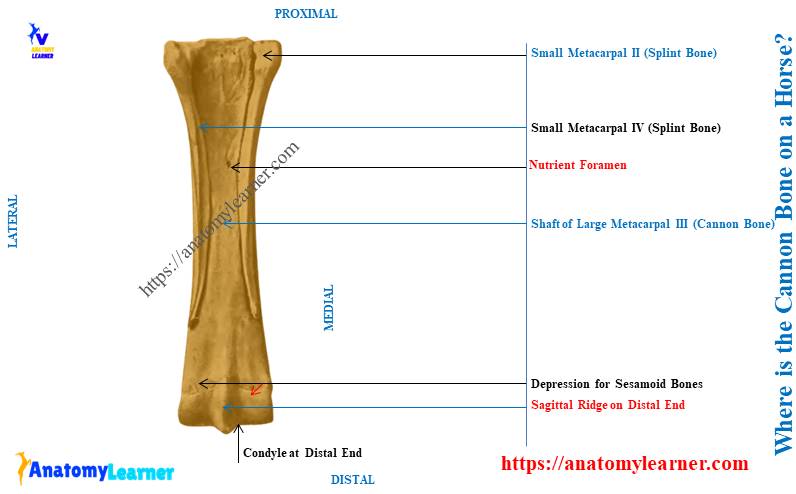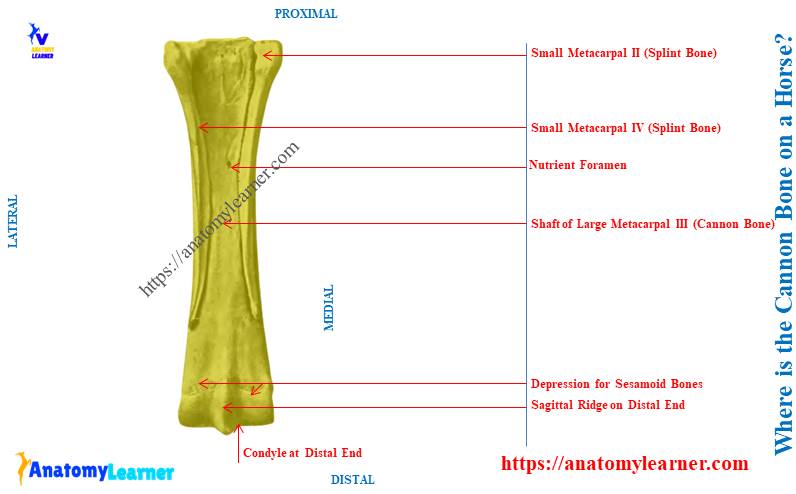You might hear the terms cannon and splint bones on a horse leg. These are the bones from the manus of the equine front limb. Here, you will know the answer to the question – where is the cannon bone on a horse?
Quick answer: large metacarpal of the manus segment of a horse’s front limb is the cannon bone. In contrast, the small metacarpal bones are known as the splint bones in a horse. They are all located between the carpals and first phalanges and contribute to the horse manus.
Again, the large metatarsal is also known as the cannon bone. In comparison, the small metatarsal is the splint bones from the hind leg of a horse.
You will know the features of the cannon bone from the horse leg with a diagram. Again, I will show you the basic difference between a horse’s cannon bones and a cow’s.
So, let’s continue this article to learn the horse cannon bone’s number, location, and anatomical details.
Where is the cannon bone on a horse?
To understand the location of the cannon bones on a horse, you might have the idea of different segments of limbs. So, first, let’s see the segments of the front and hind limbs of a horse –
The front limb of a horse shows the below-mentioned segments –
- Shoulder segment – includes scapula bone,
- Arm or brachium segment – includes the humerus bone,
- Forearm or antebrachium segment – includes the radius and ulna bones, and
- Manus segment – includes the carpals, metacarpals, and phalanges,
Again, the hind limb of a horse shows the below-mentioned segments –
- Pelvic segment – includes the pelvic bones (ilium, ischium, and pubis),
- Thigh segment – includes the femur bone,
- Leg segment – contains the tibia and fibula bones, and
- Pes segment – contains tarsals, metatarsals, and phalanges,
All these segments from a horse’s front and back legs are identified in the labeled diagram.
Here, you will see the metacarpal of a horse consists of two types – larger and small metacarpal bones.
- Larger metacarpal (III) – 1 (one), and
- Small metacarpal (II and IV) – 2 (two)
The larger well-developed metacarpal (III) is the cannon bone of a horse leg. Again, the two ill-developed metacarpal bones (II and IV) are also known as the splint bones in the horse.
The same features also find in the back leg of a horse. That means the well-developed and larger metatarsal (III) is the cannon bone from the back leg of a horse. You will also find two small splint bones (metatarsal II and IV) in the back leg of a horse.
Let’s get an idea of different bones from horse skeleton –
Location of cannon bone in a horse
The cannon bone is located between the knee and the fetlock joint (in the case of the front leg). Again, the cannon bone from the back leg locates between the hock and fetlock joints.
The labeled horse legs diagram shows these cannon bones’ location.

Let’s get an idea of the different joints of animal legs from the below-mentioned article –
Let’s see the summary of the location of the horse cannon bones from Table 1 –
| Cannon bones name | Where is the cannon bone on a horse? |
| Metacarpal (III) | In between carpals and the first phalanx |
| Metatarsal (III) | In between tarsals and the first phalanx |
How many cannon bones are there in a horse?
In a horse’s limbs, you will find 4 cannon bones (2 large metacarpals and 2 large metatarsals). Let’s see the number and name of the cannon bones from a horse –
- Right and left larger metacarpal – 2 (two) bones, and
- Right and left larger metatarsal – 2 (two) bones,
Each of these cannon bones contains 2 small metatarsals (splint bone). Thus you will find 8 splint bones in the horse limbs.
Horse cannon bone anatomy
The horse cannon bones (metacarpal and metatarsal) have similar osteological features. But you will find the difference in the appearance, length, and features on the proximal extremity between these two bones.
The ideal features of metacarpal and metatarsal bones may find in the ox leg. Thus, you may know these ideal features and differences between the ox metacarpal and metatarsal bones –
Metacarpal III bone of a horse
This is a strong long bone with a shaft and two extremities. Here, the shaft of the metacarpal III of a horse (cannon bone) is semicylindrical.
This cannon bone of a horse possesses two surfaces (dorsal and palmar) and two borders (right and left lateral). The dorsal surface of the cannon bone is smooth and convex from side to side.
Again, the palmar surface shows the convex rough surface. You will find wide grooves for small splint bones (small metacarpals) on both aspects.
The distal end of the horse cannon bone is wider and flatter than the proximal end. You will see the smooth and rounded borders on a horse’s metacarpal III or cannon bone.
Extremities of metacarpal III bone of a horse
The proximal extremity of the horse cannon bone possesses articular surfaces for the distal row carpals. You will also find small facets on either side of the proximal extremity of the cannon bone.
These small facets are designed for articulation with the small metacarpal bones (II and IV).
You will also find the metacarpal tuberosity toward the medial aspect of the dorsal surface. Within this metacarpal tuberosity, the tendon of the extensor carpi radialis muscles insert.
The palmar surface of the proximal extremity of the metacarpal bone shows the roughened area. This area is for attachment of the suspensory ligament.
You will find the articular surface at the distal extremity of the horse metacarpal. And this articular surface is for only the proximal end of the first phalanx.
“The horse metacarpal is only one developed bone (III) in the front limb that posses only one developed digit.”
You will find two fossae on the palmar aspect of the horse metacarpal for 2 sesamoid bones. The sagittal ridge separates these two fossa. The sesamoid bones, distal articular surface of the metacarpal, and proximal articular surface of the first phalanx form the fetlock joint.
The small metacarpal (II) attaches to the medial aspect of the large metacarpal. In contrast, the small metacarpal (IV) attaches to the lateral aspect of the large metacarpal.
Metatarsal III of horse (cannon bone)
You will also find 3 bones in the metatarsus of a horse. Where the III is well-developed and known as the larger metatarsal (cannon bone). The rest 2 (II and IV) are the small metatarsal or splint bones in the horse’s back limb.
The arrangement and osteological features are almost the same as the metacarpal, with little difference. You will find a difference in the direction of the horse metatarsal compared to the metacarpal bone.
The direction of the horse metatarsal is slightly oblique, downward, and a little forward. Here, the large metatarsal (III) is about one-sixth longer than the corresponding metacarpal of the horse.

Again, the shaft of the metatarsal III shows a more cylindrical appearance. Sometimes it shows a circular appearance in the cross-section.
The lateral aspect of the proximal end shows a groove where the great metatarsal artery runs. Again, you will also find an impression on the medial aspect of the proximal end.
The nutrient foramen is relatively larger than on the horse metacarpal. Again, the proximal extremity of the horse metatarsal is much wider than the metacarpal.
The proximal extremity also shows two pairs of articular surfaces for the small metatarsal or splint bones. You will find almost similar osteological features at the distal extremity of the corresponding metacarpal.
Table 2 shows the major differences between the metacarpal and metatarsal cannon bones of the horse –
| Features | Cannon bone of the front leg | Cannon bone of the hind leg |
| Name of horse cannon bone | Large metacarpal III | Large metatarsal III |
| Length | Small | Longer |
| Body | Semicylindrical | More cylindrical |
| Nutrient foramen | Smaller | Larger and higher |
What is the cannon bone on a cow compared to the horse?
The larger metacarpal (fused III and IV) and large metatarsal (fused III and IV) are the cannon bones in the cow. You will find a great variation in the structure of the cannon bones between the horse and cow.
Here, the large metacarpal of the cow consists of two fused bones (metacarpal III and IV). But you will find only one developed and large metacarpal in horse (III).
Thus, you will see longitudinal median grooves on both the dorsal and palmar surfaces of the cow cannon bones. Again, these bones show intercondyloid cleft at the distal end. But you will not find any intercondyloid cleft at the distal end of the horse cannon bones.
Cow cannon bone
The large metacarpal (cannon bone from the front leg) of a cow possesses a shaft and two extremities. Here, the cow cannon bone shaft is irregularly cylindrical and presents 2 surfaces and 2 borders.
The dorsal surface of the cow metacarpal presents a vertical groove with two foramina. Again, the palmar surface also presents similar features to the dorsal surface.
The proximal extremity of the cow metacarpal (cannon bone) shows two articular surfaces for the carpal bones. Again, you will see the metacarpal tuberosity at the dorsomedial surface of the proximal end.
The distal end consists of two condyles with an intercondyloid cleft. There are 4 depressions for the sesamoid bones on the palmar surface at its distal end.
The cow cannon bones from its hind leg are compressed transversely. It presents four surfaces and deep dorsal and plantar verticle grooves compared to the metacarpal.
Let’s see the major differences between the cannon bones of horses and cows from Table 3 –
| Features | Horse cannon bone | Cow cannon bone |
| Number in a front leg | One | Two fused |
| Depression for sesamoid | Two | Four |
| Verticle groove | Absent | Present |
| Intercondyloid cleft | Absent | Present |
| Splint bone | Postero-lateral, and Postero-medial | Postero-lateral |
Conclusion
So, you got the answer to the question – where is the cannon bone on a horse? The large metacarpal and metatarsal are the cannon bone in the horse legs.
Here, the front leg cannon bone is larger than the hind leg cannon bone in a horse. They are comparatively strong bones, forming the knee and fetlock joint in the horse’s front leg.

